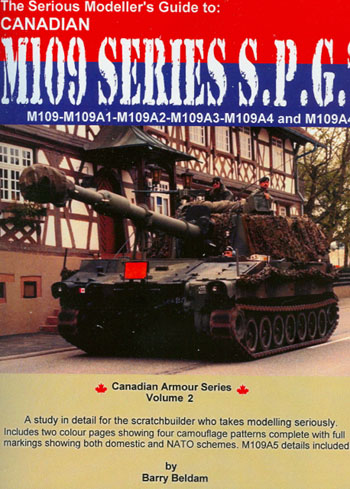Canadian Armour Series Volume 2:
The Serious Modeler's Guide to Canadian M109 Series 155mm Self Propelled
Guns
by Barry Beldam

Quarter Master's Depot, 1071 Ambleside Drive, Suite 1111, Ottawa, Ontario
K2B 6V4, Canada (http://www.quatermastersdepot.com), 2005; 217 pp. plus
color foldouts; ISBN 0-9734277-1; price CDN $45.00 (about US $37.50)
Advantages: clear, cleaned-up sections of manual pages with clear descriptions
of details where required; accompanied by clear, modeler-oriented photos
of M109A4 guns in service; cheaper and better quality than original manuals
Disadvantages: while applicable to all M109 guns less Paladin, may discourage
orders by its title
Rating: Highly Recommended
Recommendation: for artillery fans and all modelers working on M109 related
projects
The M109 is the prototype for all modern self-propelled artillery, as
it is light, compact and capable of both quick movement and relatively
sustained fire with relatively good working conditions for its crew, including
armor protection. Having been in service for 42 years, it has gone through
a number of variants, most of which still retain the same basic characteristics
and components.
This new book by well-known modeler and Canadian military writer Barry
Beldam covers most of the major versions of the M109, even though its
primary focus is the current Candian M109A4+ variant of the gun. Here
is a quick recap to show what I mean:
M109 – original variant, with a 20 caliber long howitzer and unique
bore evacuator.
M109A1 – improved variant, with 39 caliber long gun and automotive
improvements.
M109A1B – A1 built new (A1s were converted from M109s.)
M109A2 – an improved variant with more changes including an all-weather
armored head for the gunner's panoramic sight.
M109A3 – M109A1 brought up to A2 standards.
M109A4 – improved M109A2 and M109A3 guns with improvements to
internals, new NBC protection system and other modifications.
M109A5 – M109A4 brought up to near M109A6 standards less its new
turret (e.g. GPS and other changes to internal parts.)
M109A6 – Paladin, with new turret, barrel lock, etc.
As can be seen, there is a lot of commonality among the guns. Barry covers
all of the items of interest to modelers, mixing photos with manual illustrations,
and as a result provides a very handy "one-stop shopping" document
for anyone who wants to do a detailed version of the 109. Note that this
book, as it states in its title, only covers the standard versions of
the M109 as used by the US, Canada and a few other NATO countries, and
not the Israeli or German modifications in other than passing.
With the fact that there are at least three companies marketing M109
interior and detail sets, this book is an invaluable aid to anyone doing
one up "right" as it provides the where and how which many resin
kit directions seem to invariably lack. Combined with the new book on
the history of the M109 by Steve Zaloga (Osprey New Vanguard Number 86;
M109 155mm Self-Propelled Howitzer 1960-2005) it provides nearly all a
modeler may want to know on the 109. (I am a 109 fan, as I did manage
to get a license to drive one while on active duty; it reminded me of
a 32-ton sports car with eight foot of gun tube sticking out in front
which you had to be careful about when near trees!)
Thanks to Quarter Master's Depot for the review copy.
Cookie Sewell
|